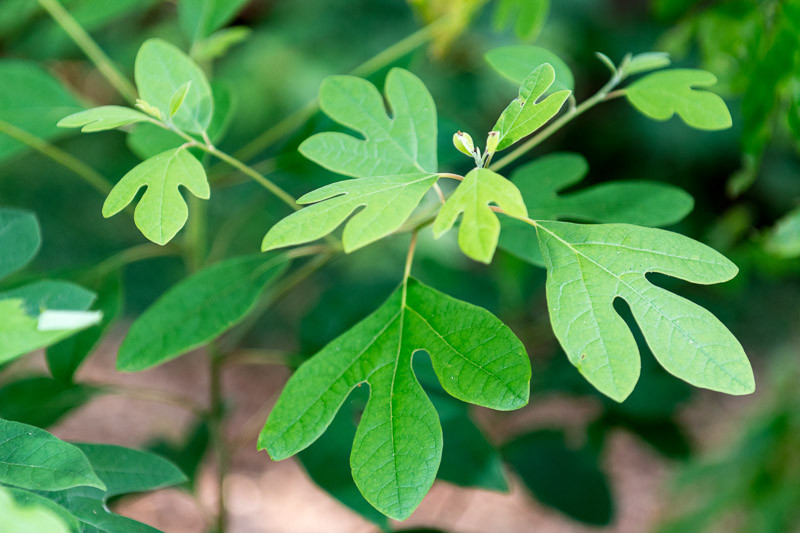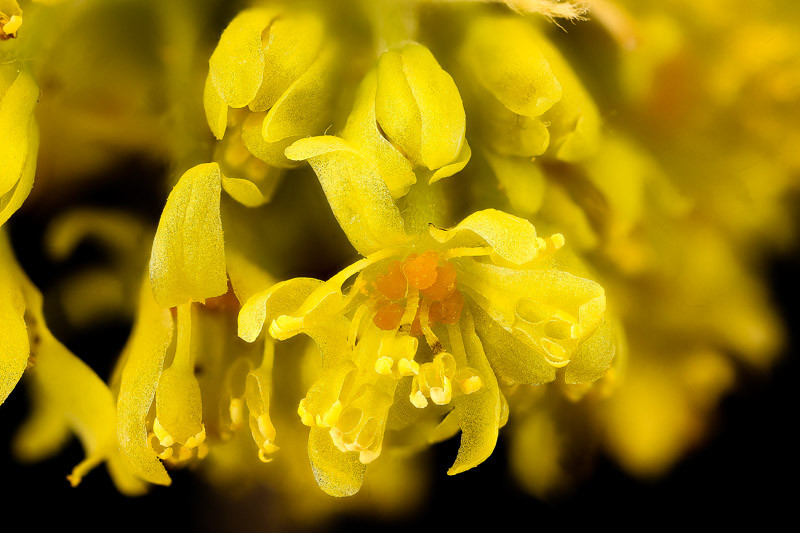Sassafras, Ague Tree, Sassafras Tree, White Sassafras, Cinnamon Wood, Mitten Tree, Saloop, Smelling Stick, Sassafras officinale, Sassafras variifolium
Sassafras albidum is a versatile and ecologically valuable tree cherished for its unique foliage, aromatic properties, and colorful fall display. While historically significant for its various uses, contemporary interest primarily lies in its ornamental and wildlife-supporting attributes.
Sassafras albidum, known for its distinct aromatic properties and notable in folk medicine, is a medium-sized deciduous tree. It’s renowned for its unique leaf shapes and vibrant fall color. All parts of the tree are aromatic.
Native: Native to eastern North America, sassafras is found from Maine to Florida and as far west as Texas.
Plant Type and Habit: Sassafras is an upright deciduous tree of dense, pyramidal to highly irregular habit with horizontal branches in cloud-like tiers. This flowering tree spreads by root suckers and can form a small grove. However, it is easily controlled as a single tree. Its lifespan is typically around 50 to 100 years. Some individual trees may live longer under optimal conditions and with proper care.
Size: A mature sassafras tree typically grows 30-60 feet tall (9-18 meters) with a spread of 25-40 feet (7.5 to 12 meters).
Flowers and Fruits: Sassafras trees produce sprays of small, yellow flowers at the branch tips in spring, before or with the leaves. The tree is dioecious, meaning individual trees are either male or female. The pollinated flowers on female trees give way to small pendant clusters of red-stalked, dark blue berries, which mature in early fall.
Foliage: The bright green leaves are 4-7 inches long (10-18 cm), with two or three distinct lobes, and turn vibrant shades of yellow, orange, and red in the fall.
Bark: Young trees have smooth, greenish bark, which becomes deeply ridged, furrowed, and dark cinnamon to mahogany-brown with age, providing winter interest.
Hardiness: It is hardy in USDA zones 4-9.
Uses: Historically used for its aromatic properties and as a flavoring agent in foods and beverages, including root beer. It’s also valued for its ornamental qualities and used in landscaping as a specimen plant, in groupings, cottage gardens, or as an informal hedge or screen. It’s known for its root system, which can sprout new trees, effectively controlling erosion.
Wildlife: Sassafras fruits are eaten by small mammals and many species of birds, including northern bobwhites, eastern kingbirds, great crested flycatchers, phoebes, wild turkeys, catbirds, flickers, pileated woodpeckers, downy woodpeckers, thrushes, vireos, and mockingbirds. Sassafras is also a significant host plant for several butterfly species, notably the Spicebush Swallowtail butterfly (Papilio troilus).
Deer and Rabbits: It has a moderate deer and rabbits browsing resistance.
Drought / Salt Tolerance: Once established, Sassafras trees are drought-tolerant.
Toxicity: Sassafras contains safrole, a compound found in the oil which is carcinogenic. Its use in foods and drinks is now regulated.
Invasiveness: Sassafras is not known to be invasive.
Benefits: Ecologically, it provides food for wildlife and is used in reforestation projects. The fall foliage adds aesthetic value to landscapes.


While generally minor, Sassafras trees can be affected by:
Wood-Boring Weevil Larvae: These larvae bore into the wood of Sassafras trees, creating tunnels and weakening the tree structure, potentially leading to branch breakage or tree death if infestation is severe.
Gypsy Moths: Caterpillars of gypsy moths feed on the leaves, causing significant defoliation, which can weaken the tree and, in severe cases, lead to its death.
Loopers: Loopers, or inchworms, consume Sassafras leaves, leading to defoliation. While typically not fatal, heavy infestations can stress the tree and reduce its overall health and vigor.
Japanese Beetles: These beetles feed on the leaves of Sassafras trees, creating skeletonized foliage and potentially reducing the tree’s ability to photosynthesize, thus impairing its growth and health.
Laurel Wilt Disease: Caused by a fungus transmitted by the redbay ambrosia beetle, this disease can be lethal. It blocks the tree’s water-conducting system, leading to wilting and death.
Leaf Blight: Leaf blight in Sassafras is characterized by dark, water-soaked spots on leaves, eventually causing them to wilt and fall off. Fungal in nature, it thrives in moist conditions.
Leaf Spot: This fungal condition presents as small, discolored spots on leaves, potentially leading to premature leaf drop. Good air circulation and avoiding overhead watering can minimize its occurrence.
Nectria Canker: Caused by the Nectria fungus, this disease creates sunken, swollen areas on branches and trunks, interrupting the tree’s vascular system and potentially leading to branch dieback.
American Mistletoe (Phoradendron flavescens): This parasitic plant attaches to tree branches, drawing nutrients and water, which can weaken or even kill parts of the host tree over time.
Leaf Drop: Sassafras trees may drop leaves in response to environmental stress, such as drought or excessive moisture.
Sensitive to Transplanting: Young sassafras trees can be sensitive to transplanting and require careful handling.
Root Suckering: Sassafras trees often produce suckers from the roots, which can be problematic in landscaped areas.
| Hardiness |
4 - 9 |
|---|---|
| Heat Zones |
3 - 8 |
| Plant Type | Trees |
| Plant Family | Lauraceae |
| Common names | Sassafras |
| Exposure | Full Sun, Partial Sun |
| Season of Interest |
Spring (Early, Mid, Late) Summer (Early, Mid, Late) Fall Winter |
| Height |
30' - 60' (9.1m - 18.3m) |
| Spread |
25' - 40' (7.6m - 12.2m) |
| Maintenance | Average |
| Water Needs | Low, Average |
| Soil Type | Clay, Loam |
| Soil pH | Acid, Neutral |
| Soil Drainage | Moist but Well-Drained, Well-Drained |
| Characteristics | Fragrant, Showy, Fruit & Berries |
| Native Plants | United States, Northeast, Pennsylvania, Rhode Island, Vermont, Connecticut, Delaware, Maine, Massachusetts, Maryland, New Hampshire, New Jersey, New York, Midwest, Ohio, Missouri, Michigan, Wisconsin, Kansas, Iowa, Indiana, Illinois, Southeast, Louisiana, Mississippi, North Carolina, South Carolina, Tennessee, Virginia, West Virginia, Alabama, Arkansas, Florida, Georgia, Kentucky, Southwest, Texas, Oklahoma |
| Tolerance | Drought, Dry Soil, Clay Soil |
| Attracts | Birds, Butterflies |
| Garden Styles | Informal and Cottage |
| Hardiness |
4 - 9 |
|---|---|
| Heat Zones |
3 - 8 |
| Plant Type | Trees |
| Plant Family | Lauraceae |
| Common names | Sassafras |
| Exposure | Full Sun, Partial Sun |
| Season of Interest |
Spring (Early, Mid, Late) Summer (Early, Mid, Late) Fall Winter |
| Height |
30' - 60' (9.1m - 18.3m) |
| Spread |
25' - 40' (7.6m - 12.2m) |
| Maintenance | Average |
| Water Needs | Low, Average |
| Soil Type | Clay, Loam |
| Soil pH | Acid, Neutral |
| Soil Drainage | Moist but Well-Drained, Well-Drained |
| Characteristics | Fragrant, Showy, Fruit & Berries |
| Native Plants | United States, Northeast, Pennsylvania, Rhode Island, Vermont, Connecticut, Delaware, Maine, Massachusetts, Maryland, New Hampshire, New Jersey, New York, Midwest, Ohio, Missouri, Michigan, Wisconsin, Kansas, Iowa, Indiana, Illinois, Southeast, Louisiana, Mississippi, North Carolina, South Carolina, Tennessee, Virginia, West Virginia, Alabama, Arkansas, Florida, Georgia, Kentucky, Southwest, Texas, Oklahoma |
| Tolerance | Drought, Dry Soil, Clay Soil |
| Attracts | Birds, Butterflies |
| Garden Styles | Informal and Cottage |
How many Sassafras albidum (Sassafras) do I need for my garden?
| Plant | Quantity | |
|---|---|---|
| Sassafras albidum (Sassafras) | N/A | Buy Plants |
Create a membership account to save your garden designs and to view them on any device.
Becoming a contributing member of Gardenia is easy and can be done in just a few minutes. If you provide us with your name, email address and the payment of a modest $25 annual membership fee, you will become a full member, enabling you to design and save up to 25 of your garden design ideas.
Join now and start creating your dream garden!
Create a membership account to save your garden designs and to view them on any device.
Becoming a contributing member of Gardenia is easy and can be done in just a few minutes. If you provide us with your name, email address and the payment of a modest $25 annual membership fee, you will become a full member, enabling you to design and save up to 25 of your garden design ideas.
Join now and start creating your dream garden!